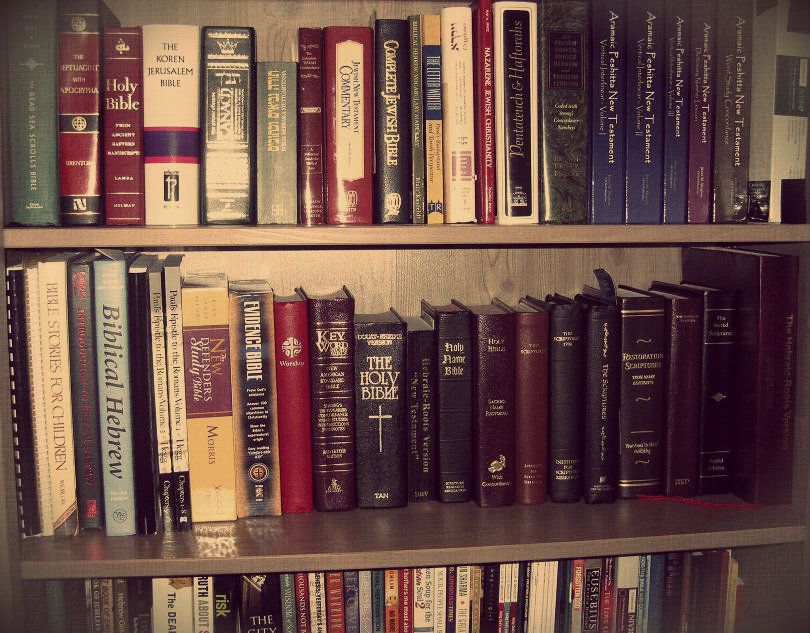

Although no translation is without bias, this is the most accurate mainstream Christian Bible available and reads very smoothly. Unlike other Christian versions such as the NLT, NIV, Goods News, or Message which are primarily made up of translator commentary and not the word of G-d, the NASB is fairly accurate to the underlying Hebrew Masoretic and Critical Greek text. I do not recommend getting a study bible with biased commentary but rather a simple reference edition. The Cambridge Wide Margin Reference edition is my personal favorite because it is one of the few NASB's in paragraph format and the wide margins are fantastic for note taking. I've used the margins to mark the parasha portions and haftarah readings, textual critical notes such as alternative manuscript readings, Aramaic variations from the Greek, Hebraic idioms and explanations of difficult phrases that get taken out of context, as well as many other handy notes that are especially useful when you go to Yeshiva or Bible Studies (see a sample picture here). In other words, this allows you to create your own Study Bible over the course of your life with a fairly accurate text. Cambridge craftsmanship is also top notch, with excellent binding and clear, crisp printing, both of which will last you a lifetime. The size of the book might seem awkward for those used to smaller bibles, but it's definitely worth getting used to.
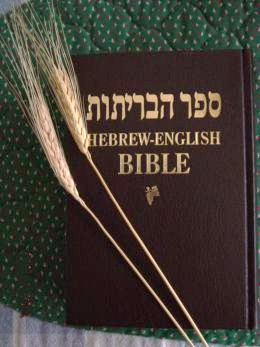
Although not as literal or Hebraic flowing as the NASB, the NKJV is still a very decent translation. The Apostolic Scriptures come from a different source text than the NASB, the infamous "Textus Receptus" that the KJV is based upon. Sadely, this edition of the NKJV does not have all the textual critical notes of the regular NKJV. But my recommendation of this is not because of the NKJV in and of itself, but because this is the only Bible that has Genesis to Revelation in one single book with both English and Hebrew. The print is a little small, but the quality of the print is dark, crisp and clear. The hardback edition is better than the leather edition, even though it doesn't have gold gilding and only one as opposed to two ribbon markers. The Hebrew is the masoretic text for Tanach and the modern Hebrew translation by the Bible Society in Israel for the B'rit Chadasha. If you need Hebrew for the entire canon of Scripture in a compact form, this is it. The pages are not too thin so there's not much bleed through, but at the same time, this Bible is not very thick either which is impressive considering you have the entire Bible in two languages. The Bible Society in Israel also translated the Peshitta into Hebrew, so this is a good edition to compare their modern Hebrew from the Greek to their Hebrew Peshitta. In any case, if you wanted the Hebrew along with a Christian Bible or simply a NKJV, then this is a very ideal Bible to purchase.
Sacred Name Bible
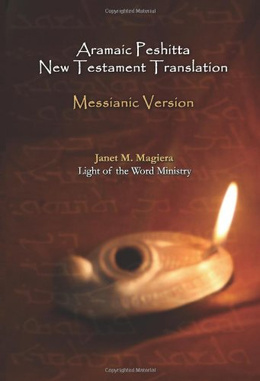
Aramaic Peshitta New Testament Translation: Messianic Edition
From an honest perspective, I cannot endorse or recommend the majority of Sacred Name Bibles out there as they typically will include less than honest translation errors of one sort or another. Further, it's authors are often pseudo-scholars, relying on things like Strong's concordances and dictionaries as opposed to a genuine knowledge of the language that is then peer reviewed by other men of faith. For the Apostolic Scriptures however, one translation that I can reccomend which uses original Semitic names for people, places and our G-d, is the Messianic Edition of Janet Magiera's Peshitta translation (her non-Messianic version can be read for free here). These transliterated names of course will be Aramaic and not Hebrew, as the source text is the Aramaic Peshitto, and the Aramaic/Syriac texts are the only reliable Semitic sources for the Apostolic Scriptures. I'm not against the possibility of a Hebrew original, but we haven't found it if it exists, so we must work with what we have if we're being honest. So, as far as Magiera's translation goes, I believe it contains the least amount of bias of any of the Aramaic translations so far, and this edition of hers is also free of any commentary. All you will see is a Messianic sensitive text with Aramaic transliterations (reflecting the underlying text as opposed to inserting Hebrew names and terms). For the Tanach, probably the best Sacred Name Bible translation(s) would be the ISR's "Scriptures" or maybe "The Word of Yahweh". But you can go and read all of my reviews of the major Sacred Name Bibles on the front page and then decide for yourself which one you would like.
Messianic Scriptures
This is the first Messianic translation to be done by a team of scholars rather than an individual. Their aim is to be as accurate as the NASB, as venerable as the KJV, and as smooth as the NIV. The source text for the Apostolic Scriptures is the 27th edition of the Nestle-Aland Greek text, siding with the majority of scholarly opinion in the west. Now, my recommendation of this is that it is a much more literal/accurate translation than Stern's Complete Jewish Bible (which is his interpretative paraphrase; sometimes this is good, sometimes not) and as it is being done by a team of scholars who are fluent in the Biblcal languages, it should be much more accurate and faithful to the underlying texts in comparison to the pseudo scholarship "versions" that have plagued the messianic movement! It should also be noted that this is almost a completely original translation. While they are using the ASV (1901) as a base text, it is being completely reworked (you can't even tell it was the ASV at one point) and the translators for this Bible are fluent in the original languages and understand the Scriptures from a Hebraic perspective (all of them being raised Jewish [Messianic] themselves). This means we will be getting an honest, valuable translation for the Messianic Jewish movement. It's not a revision of a text as we so often see in this movement, but a real translation! Although we already have have an abundance of English translations, many of them come from the KJV tradition with not a single one being Messianic Jewish sensitive. No translation is perfect though, and the TLV team seems to be conservative in their translation in that they are not very eager to step outside the traditional rendering of certain passages. But nonetheless they do get it right in a number of key places, and I believe this is worth investing in for a devotional bible. If you are raising a Messianic Jewish family, this edition will also be perfect as it is designed for exactly that purpose: family Scripture reading. But I would say I am in big support of this translation simply because the Messianic Movement needs more legitimate rather than pseudo-scholar versions (all of which I have purchased and reviewed, so I know).
Study Bibles
Pentateuch and Haftorah's - J.H. Hertz (Hertz Chumash)
Other than commentaries on individual books, there are no Messianic Study Bibles. Tim Hegg has written absolutely excellent commentaries on Romans and Galatians which I reccomend over David Sterns complete commentary on the New Testament. But as far as actual study bible matieral that may be useful for the Messianic believer, a good balanced starter for the basics of the Tanach from a Hebrew perspective would be the Hertz Chumash. Although this only covers the Torah, Haftorah and other holiday readings as opposed to the entire Tanach, a Chumash is still an indispensable resource. While some may criticize use of Hertz because it is not Messianic, it is above all the Christian study bibles I have read because on a general basis, Observant Jews tend to know Torah much better than grafted in Believers who remain Goy in many ways. However, for more of a Messianic perspective, we have to go beyond the study bible level and turn to commentaries (which are mostly focused on the Torah). There is the Walk: Messianic Jewish Devotional Commentary Collection which covers the five books of Moses, or you can get Rabbi Yehuda ben Shomeyr's various Torah commentaries and devotionals which give you a Netzari perspective. Finally, some free, but excellent teachings on the weekly Torah parasha are available from Yoseph Veil, Tim Hegg, David ben Gavriel, and FFOZ. You can also find teachings on the Parasha and Festivals on the Hebrew Visions News blog (although there will be other material as well). Now, although I do use them personally, I am not big on recommending the ArtScroll Stone Edition Tanach or Chumash because their commentary can sometimes be too Orthodox and anti-Mashiyach. While they do have absolutely beautiful bindings and publications, you are much better off starting with the Hertz Chumash before trying ArtScroll. To grasp the merit of ArtScroll publications, you need to be grounded in Mashiyach and know how to glean from things (sorting the wheat from the chaff you could say). Truly this is needed for all Study Bibles though. The Etz Chayim Chumash from JPS is also quite good. I have only looked at it briefly during Torah Study with a fellow believer, but it has shown itself in the short passages I have read to be my favorite out of all of them!
Interlinears and Lexicons

The Interlinear Bible: Hebrew/English (4 Volume Set) - Jay P. Green
This four volume interlinear is much more accurate than other interlinears out on the market. I recommend the more expensive four volume version because the one volume version has print that is far too difficult to read, especially for the Hebrew (the vowel points are almost impossible to decipher). The first three volumes are for the Hebrew Tanach (although the books are not in the order of the Hebrew Tanach), and the 4th colume is a Greek interlinear for the Textus Receptus that is far superior to the highly biased interlinears available from Zondervan and others. Green's Literal translation is also a welcome tool for study. A free online interlinear can be found at bible.cc, or one can be downloaded from Scripture4all.org.
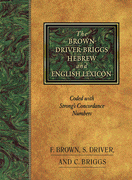
This is the standard lexicon used in all university level courses for Biblical Hebrew. Despite the critical reviews you may read on amazon, texts become standard for a reason and it's good to use standardized material for a number of reasons. First, it's time tested and trusted. Second, it's what most people in the academic world use, making it easy when you associate on that level. Third, it's highly superior to Strong's. Fourth, it helps you to learn Hebrew a lot better because the words are arranged by their root. But, for those who do not know Hebrew and are more comfortable with Strong's numbering, there is an index at the back with Strong's numbering for all the words, making it easy to find them quickly. The BDB is standard learning material for those wanting to dive into the Hebrew. You can find the basics of it online for free here, but the printed version has a lot more detail.
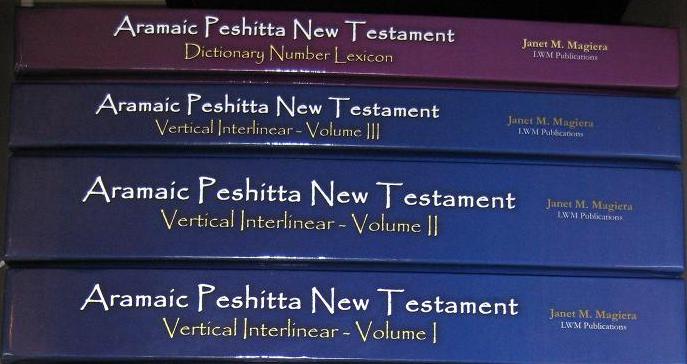
Although Magiera has Hellenized a Semitic text, her resources for the Aramaic Renewed Covenant are irreplaceable at this time. The vertical interlinear format is extremely easy to use and she has numbered every word to correspond with the lexicon she has available. This means that you can apply the same level of textual study to the Aramaic as everyone does with the Greek using Strong's numbering. Just be warned that Magiera uses the Western Peshitto instead of the more accurate Eastern Peshitta. The differences between the two texts are quite few though, and you can go in and write the changes (found here) in about fifteen minutes or less. Well worth the investment if you'd like print format. However, the cheaper and quicker alternative for most of us would be the Peshitta Tool at Dukhrana Biblical Research.
This is the corresponding numbered dictionary to go with her interlinears and has been an unparalleled reference for me. It is the only of it's kind available and highly worth the investment (other lexicons require you to have a very working knowledge of the language). This dictionary is extremely easy to use and lists the corresponding Strong's numbers for Hebrew equivalents, allowing you to tie in key words and concepts directly to the Tanach using BDB.
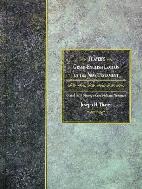
Thayer's Greek Lexicon is an affordable print option for something that is superior to the basics of Strong's dictionaries. This particular edition however is coded with Strong's numbers making it very easy to find words if you have Green's interlinear or a Strong's Concordance with the KJV. Thayer's is available online for free at biblestudytools.com. Now although these online tools are quicker and more efficient than using print format, I must stress how nice it feels to get away from the computer sometimes and sit quietly with a printed text for studies. They're especially good for studying the word on Shabbat since most of us spend far too much time on the computer during the rest of the week. But for time efficiency I must admit that most of my study is done using computer tools.

The Dead Sea Scrolls Bible - Abegg, Flint, & Ulrich
No introduction needs to be given for the Dead Sea Scrolls, the oldest sets of Scriptural manuscripts we have available. This edition of the Dead Sea Scrolls includes all of the books in our Canonized Scripture as well as the Deuterocanonical texts (Apocrypha). The other edition of the Dead Sea Scrolls contains translations from various texts which, while valuable, are not appropriate for textual criticism of the Canonical Scriptures. It needs to be noted however that while the books are in correct Hebrew order, there are no book headings at the top of the page like you'd see in a regular Bible. This means you cannot simply flip through to find a book easily. To solve this problem, you can insert Bible Index Tabs. Just be sure to get the Catholic ones so you can label the Apocryphal books. I used the left over New Testament tabs for my Aramaic English New Testament.

The Septuagint is most likely the oldest translation of the Tanach which predates the birth of Mashiach, making it a very valuable tool for Textual Criticism. This hardcover edition is very nice and has both the Greek and English in separate columns. It is also in paragraph formatting, helping with context. The chapter divisions are labeled in Roman numerals though, so you might have to brush up on those if you're not used to them. An alternative translation, the New English Translation (NET), can be read online for free here. The NET reads quite similar to the NKJV where as Brenton's translation reads much similar to the old English of the original KJV.

The Aramaic Tanach (also known as the Peshitta Tanach or "Syriac Old Testament") is another historical translation of the Hebrew Tanach. Some say it could be translated as far back as the time of Babylon in 500 BCE, or it could have been translated around the time of the Apostles. Regardless, it is translated from a source which pre-dates any of the Masoretic texts, making it just as valuable as the Greek Septuagint for Textual Criticism. The Lamsa Bible is the only English translation of this text available and comes without much bias. The same however cannot be said for his New Testament translation and I therefore recommend this on the basis of the Tanach only. It can be read online for free at Lamsa Bible.com.
Until the Biblia Hebraica Quinta is completed, this is the gold standard for the Tanach. Not only is it the most accurate print version of the Hebrew Masoretic text available, it also includes extensive textual footnotes showing variations from all the major families of manuscripts (Syriac, LXX, etc.). This is why it is the standard text for colleges and most major translations of the Scriptures. This edition has a suitable print size where as the smaller edition is more difficult to read (particularly the marginal notes; the main text is okay unless your eyes are getting a little bit wiser than us younger folks). Please note that this text, introduction aside, is 100% Hebrew. If you cannot read Hebrew this text will not help you. Instead, for Textual studies using the Hebrew Masoretic Text I recommend you get any Bible program that has an interlinear, go to an online interlinear, or if you really want print format, purchase (as noted above) The Interlinear Bible: Hebrew/English (4 Volume Set) by Jay P. Green. Now if you can read Hebrew, the edition linked above is the best printed format of this text. But if you happen to have yours fall apart or you want it to be of the highest possible quality (perhaps you're a reader of Bible Design Blog like me?), then you might want to try a rebind like you see here. After all, if you've taken the time to learn Hebrew, you likely hold the Word in very high esteem and might at some point want to give it a superior binding (I may do this with mine at some point, and also have my Hebrew Aramaic Peshitta [discussed below] done at the same time, having them bound to match).

For the Renewed Covenant, the Eastern Peshitta is arguably the most accurately transmitted N.T. text and as such, may be the most original New Testament we have available today. I realize this is not the majority of scholarly opinion, but the Peshitta needs more scholarly attention to properly address the points made by Eastern Peshitta primacists such as Paul Younan. According to Younan, the Eastern family of texts is over 99% identical to one another (which would mean it has a higher level of textual accuracy than even the Masoretic text), and all variations are claimed to be variations in dialect/spelling only, so the meaning of the text is never changed. It is also proclaimed to be grammatically perfect. If all of these things are true then despite what language the N.T. was originally written in, from a position of transmission alone this is a textual witness that holds A LOT of weight. Now this edition linked above should be standard reading for any Jewish anti-missionary who I've been told will immediately notice the differences from the Greek texts. I've also been told that anyone raised studying the Hebrew texts will clearly see how this Semitic text lines up perfectly with Hebraic thought and the Hebrew Tanach (and my limited study of the text and the Hebrew language and culture is inclined to agree). For Orthodox Jews, this fluidity is a tell tale sign of divine inspiration. We also see in the Peshitta that every strange reading found in the Greek may be cleared up and in some cases shown how it was even a mistranslation of the underlying Aramaic word. These are the evidences we have for an Aramaic original. Now, this edition has the Aramaic text in Hebrew characters and a Hebrew translation on the opposing page (useful for the majority since most of us are more familiar with Hebrew than Aramaic). But once again, if you cannot read Hebrew then this text will not be any use for you. Janet Magiera's 3 Volume Aramaic Peshitta New Testament Vertical Interlinears with your personal notes outlining the Eastern and Western differences found here will be your best bet for textual criticism in print format if you cannot read Hebrew or Aramaic. Her regular translation includes textual footnotes indicating variances among families of Syriac texts which you may find useful as well (note: for the same thing online, use the Peshitta Tool at Dukhrana Biblical Research).The New Testament: The authorized English version with introduction, and various readings from the three most celebrated manuscripts of the original Greek text - Constantinte Tischendorf
While an interlinear is good for diving into the meaning of the words, this is the best text for Greek textual criticism. It includes the KJV text with reference to the three earliest Greek manuscripts we have available to us (Sinaiticus, Vaticanus, and Alexandrius). Every variation is footnoted, allowing you to see what is actually a majority text reading among our early sources. You can also use this with your Aramaic texts for another witness as to what may have been the most probably reading in the original. This text is public domain and available in full for free at google books.
Siddurim / Prayer Books
Orthodox
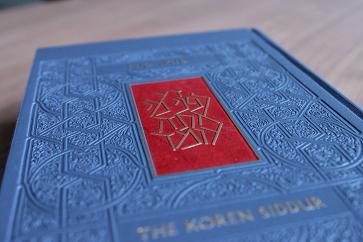
Koren Sacks Siddur - Jonathan Sacks
This is by far the best complete Orthodox Siddur. It has all the prayers for weekday (Shacharit/Mincha/Ma'ariv), Shabbat, as well as your morning blessings, bedtime Shema, the cyle of life, Feast Day prayers for at home, etc. You can view the full table of contents by looking at the preview found on amazon.com for the Ashkenazi version, as well as read reviews as to why this particular edition is so good. First of all, the layout is amazing. Koren has produced siddurim that stress the prayers through their formatting, so instead of just seeing straight block paragraphs, everything is aligned in such a way so as to enhance your prayer by making reading clear and powerful. The paper is also your thin special bible paper that is used in the Koren Tanach, which has a dark parchment tint to it that is easy on the eyes. The translation is smooth, accurate, and reflective of how you would actually be reading the text (i.e. the divine name is not written with "HaShem" but translated correctly as L-rd). One thing that catches readers by surprise is that the Hebrew is on the left hand side instead of the right, but this actually works better once you get used to it believe it or not. The cover is the same high quality Koren cover you find on their over hardcover editions, and this comes with two beautiful ribbon markers. There are many detailed reviews and pictures of this siddur, so I won't go too far in-depth, but let me just say that the typesetting, paper, binding, ribbon markers, cover, translation, introduction and commentary are all excellent. However, having that said, it is not Messianic and therefore lacks substantially for what we as Messianic Believers require. But if you are going to get an Orthodox Siddur, this would be it. They have also completed Hebrew-English Machzorim for Rosh Hashana and Yom Kippur which are of the same level of excellence. Note however that the Hebrew font is different then what some of you beginner hebrew students may be used to, so check out the font first to see if you enjoy it.

Although not released yet, I am reccomending this for a few reasons. First, we are in dire need of good Messianic liturgical resources that are to the same level of the Koren Siddur I reccomended above. As things stand now all of our resources are a far cry from the Siddurim and Machzorim within Orthodox Judaism. FFOZ has also produced an excellent Grace After Meals booklet with pretty good commentary and an excellent layout, which is promising for this complete Messianic Siddur. However, having that said, I sincerely hope that they will be inclusive in their comments and leave their divine invitation teaching OUT of it. I have e-mailed them stressing this and pray to HaShem that they will. Their Vine of David Haggadah both include this theological slant in their introductions which is very disappointing. Scripture is abundantly clear that if you belong to Messiah then you are of the seed of Abraham, so it is perfectly acceptable for you to say "our fathers" and any of the other prayers and blessings. I encourage everyone to e-mail them and stress that they should leave this out as well. May their pride not get in the way of creating unity through a needed liturgical resource.
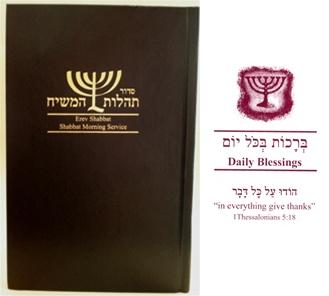
In our limited supply of good Messianic liturgical resources, Tim Hegg has produced a couple things for us. His Siddur Tehillot haMashiach contains a complete Erev Shabbat and Shabbat morning service in an double column interlinear sort of format that is easy to use but I don't find it that visually pleasing. He has in here the complete Birchat haMazon, Grace After meals, the full bedtime Shema, circumcision and brief marriage service. I use it mostly for the Bedtime Shema. The daily blessings includes most of your typical mroning blessings, as well as a variety of others for various occasions and again, the full Birchat haMazon/Grace After Meals. It is pocket sized but not very durable, so it would be good to find a nice plastic case of some sort for it. The paper and bindings on these are both basic. Tim did the translation for most of these himself, and I enjoy it. Scripture quotes are taken from the NASB, and the divien name is translliterated as "Ad-nai" throughout.
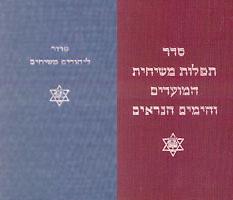
These are the siddurim that are used at my Shul. The paper and bdings are basic, like Tim's siddur, but I enjoy the layout quite a bit and find it quite aesthetically pleasing. However, the order in which things are presented are different from Orthodox Siddurim and limited (there are many more prayers than in Hegg's siddur though). The Shabbat siddur gives good ideas for how a service can be constructed, making it easy to find your way through the siddur. It also has a very good Torah Service, and the Amidah for both daily as well as Shabbat. The hebrew is on the right hand side in a good, clear, large font, and the english on the left. The Messianic selections are pretty good, although the translation is unfortunately taken from the NIV. There are also a few errors here and there, such as the last line of the third Shema paragraph in the Hebrew. But all in all it's a very decent siddur that's easy to read and easy for congregants to follow along in. The Machzor contains festival services that are Messianic flavoured, and the Messianic flavour is definitely refreshing. While traditional prayers are indeed beautiful, Mashiach brings everything to such a powerful life, which is again why I am reccomending what little liturgical resources we have in the Messianic movement. Rabbi Yehuda ben Shomeyr has an article on his website explaining how he makes his artscroll siddur Messianic flavoured though, so you could go check him out. One downfall though to this Machzor is that there are a few unkosher days in here that are not labeled by their particular label, but are still things in which we should be weary of. There are also no services for Pesach or Unleavened Bread, but there are services for circumsion, naming, holocaust rememberance, and mikvah.